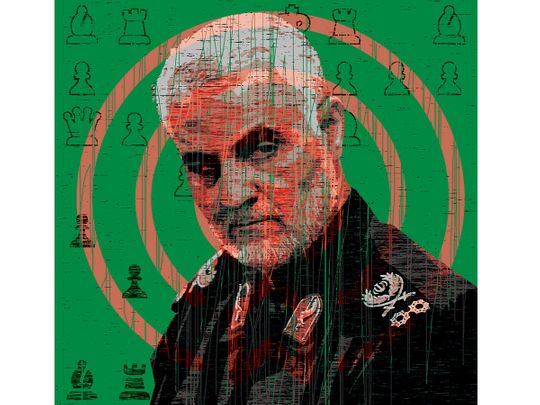
More than any other American military operation since the invasion of Iraq, the assassination of Gen. Qasim Soleimani, the head of Iran’s Quds Force of its Islamic Revolutionary Guards Corps, is a seismic event. The killings of Osama Bin Laden and Abu Bakr Al Baghdadi, the leaders of Al Qaida and Daesh [the self-proclaimed Islamic State of Iraq and the Levant], were certainly meaningful, but they were also largely symbolic, because their organisations had been mostly destroyed. Taking out the architect of the Islamic Republic’s decades-long active campaign of violence against the United States and its allies represents a tectonic shift in Middle Eastern politics.
To see just how significant Soleimani’s death truly is, it helps to understand the geopolitical game he’d devoted his life to playing. In Lebanon, Soleimani built Lebanese Hezbollah into the powerful state within a state that we know today. A terrorist organisation receiving its funds, arms and marching orders from Tehran, Hezbollah has a missile arsenal larger than that of most countries in the region. The group’s success has been astounding, helping to cement Iran’s influence not just in Lebanon but farther around the Arab world.
Building up on this successful experience, Soleimani spent the last decade replicating the Hezbollah model in Iraq, Syria and Yemen, propping up local militias with precision weapons and tactical know-how. In Syria, his forces have allied with Russia to prop up the regime of Bashar Al Assad, a project that, in practice, has meant driving over 10 million people from their homes and killing well over half a million. In Iraq, as we have seen in recent days, Soleimani’s militias ride roughshod over the legitimate state institutions. They rose to power, of course, after participating in an insurgency, of which he was the architect, against American and coalition forces. Hundreds of American soldiers lost their lives to the weapons that the Quds Force provided to its Iraqi proxies.
The United States had several past opportunities to kill Soleimani but each time decided against it. This restraint did not make the world safer. It only gave Soleimani more time to build his empire...
Soleimani built this empire of militias while betting that America would steer clear of an outright confrontation. This gambit certainly paid off under President Barack Obama, but it even seemed to be a safe bet under President Trump, despite his stated policy of “maximum pressure”. Trump was putting an economic squeeze on Iran, and popular protests in Iran, Iraq and Lebanon were adding to the pressure, but Soleimani assumed that, in the end, control of military assets would win the day. Trump, it seemed, feared getting sucked into a war. Washington, in short, lacked a ground game.
In September, Soleimani and his colleagues reportedly pressed their advantage by attacking a Saudi Arabian oilfield, an act of war that went unanswered. He followed this up by orchestrating attacks by Iranian proxies on Americans. The Trump administration had said clearly that attacking Americans was a red line, but Soleimani had heard threats in the past from American leaders. He thought he could erase Trump’s red line.
His departure will make Iran much weaker. It will embolden the country’s regional rivals to pursue their strategic interests more resolutely. It will also instill in the protesters in Iran, Lebanon and, especially, Iraq, the hope that they will one day wrest control of their governments from the talons of the Islamic Republic.
Final demise of Obama’s Middle East strategy
In Washington, the decision to kill Soleimani represents the final demise of Obama’s Middle East strategy, which sought to realign American interests with those of Iran. Obama’s search for a modus vivendi with Tehran never comported with the reality of the Islamic Republic’s fundamental character and regional ambitions. President Trump, by contrast, realised that Tehran’s goal was to replace America as the key player in the Middle East.
The United States has no choice, if it seeks to stay in the Middle East, but to check Iran’s military power on the ground. For a president elected on a platform of peace and prosperity, confronting Iran was not an easy decision to make. Trump would undoubtedly prefer to be negotiating with Iran over its nuclear programme rather than ordering the assassination of its most famous general. But the president realised that securing America’s regional position required a strong and visible response to Soleimani’s escalations.
more on the topic
In fact, such a response was long overdue. I know from my own experience, as a former senior official in the White House and the Defence Department, that the United States had several past opportunities to kill Soleimani but each time decided against it. This restraint did not make the world safer. It only gave Soleimani more time to build his empire, and, moreover, it enhanced his mystique as a man with an almost superhuman ability to evade detection.
To no one’s surprise, Trump’s critics immediately accused him of needlessly provoking Iran, arguing that Soleimani’s assassination could lead to war. This is an analysis that ignores the fact that Soleimani has been waging war on America and its allies for years and was directly engaged in the planning of attacks.
The world to which we wake up today, rid of its most accomplished and deadly terrorist, is a better place. Nowhere is this insight more evident than throughout the Middle East, where individuals are posting joyous videos to social media, celebrating the death of the author of so much of their misery. We should all — even those among us who don’t particularly care for Trump — join them in their good cheer, and continue to repeal Soleimani’s murderous anti-American legacy.
— Michael Doran, a senior fellow at the Hudson Institute, is the author of “Ike’s Gamble: America’s Rise to Dominance in the Middle East.”







